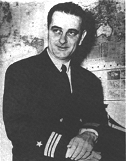Commander Lyndon B. Johnson, USNR

Related resources:
Citation for Army Silver Star Medal
Before his brief career as a naval officer, Lyndon B. Johnson worked both as a school teacher and a politician. Born to Samuel Ealy and Rebekah Baines Johnson on 27 August 1908, Johnson attended public schools in Blanco County, Texas, until he graduated from high school in 1924. Continuing his education at Southwest Texas State Teachers College in San Marcos, he earned a Bachelor's of Science in 1930. After graduation, Johnson taught at a public school in Texas.
Two years later Johnson decided to change career fields and accepted a position as secretary to Representative Richard M. Kleberg in his Washington, D.C. office. In 1935 Johnson spent one year at Georgetown Law School and then became the State Director of the National Youth Administration of Texas. In 1937, Johnson resigned this position to become a candidate for the unexpired term of Congressman James P. Buchanan from the Tenth District of Texas. During a special election, he was elected on 10 April to the 75th Congress. In 1938, Johnson was re-elected to a full term in the 76th Congress.
Appointed Lieutenant Commander in the United States Naval Reserve on 21 June 1940, Johnson reported for active duty on 9 December 1941, after the Japanese bombed Pearl Harbor. He was ordered to the Office of the Chief of Naval Operations, Navy Department, Washington, D.C. After completing his training in Washington, Johnson proceeded to Headquarters, Twelfth Naval District, San Francisco, CA for inspection duty in the Pacific. While stationed in New Zealand and Australia, he worked as an observer of bomber missions in the South Pacific, for which he was later awarded the Army Silver Star Medal.
After President Roosevelt ordered all members of Congress in the Armed Forces to return to their legislative duties, Johnson was released from active duty under honorable conditions on 16 June 1942. In 1949 he was promoted to Commander in the Naval Reserves to date from 1 June 1948. During his time in service, Johnson was awarded the Asiatic Pacific Campaign Medal and the World War II Victory Medal. After he became President following the assassination of John F. Kennedy, Johnson's resignation from the United States Naval Reserve was accepted by the Secretary of the Navy effective 18 January 1964.
Former Commander Lyndon Baines Johnson, U.S. Naval Reserve
Transcript of Naval Service
27 AUG 1908 Born in Stonewall, Texas
21 JUN 1940 Lieutenant Commander, U.S. Naval Reserve
9 DEC 1941 Reported for active duty
16 JUL 1942 Released from active duty under honorable conditions
19 OCT 1949 Commander, to rank from 1 June 1948
18 JAN 1964 Resignation from Naval Reserve accepted by Secretary of the Navy
SHIPS AND STATIONS
Office of the Under Secretary of the Navy, Dec. 1941-Jul. 1942
Department of the Navy, Washington 25, DC
09 September 1997


